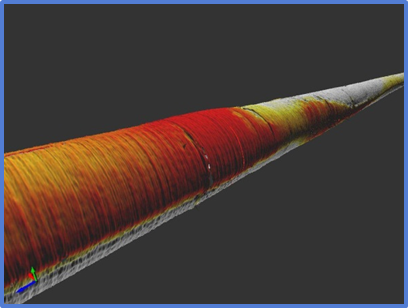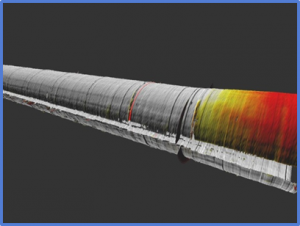March 2015, Vol. 70, No. 3
Features
Unique Fort Worth ICAP Proves Effectiveness

The city of Fort Worth is in the fourth year of a multi-year program with the goal of inspecting all of its large-diameter sanitary sewer lines, grading their condition in order to schedule needed repairs and rehabilitation, and addressing the most critical needs first. (A separate program addresses smaller-diameter pipes.)
The Fort Worth Interceptor Condition Assessment Program (ICAP) was initiated in 2010 with a goal of inspecting 100 percent of pipe 24 inches and larger over a seven-year period, pending available funding. “At the end of 2014, inspection of 147 miles of pipe had been completed or approximately 60 percent,” said Darrell Gadberry, Fort Worth Water Department (FWWD) field operations division regulatory and environmental coordinator.
“The ICAP program,” Gadberry explained, “allows the FWWD to identify locations of probable failure and replace or rehabilitate the pipe before failure occurs. The cost to replace or rehabilitate a large diameter pipe before it collapses is a fraction of the cost to address pipe failure after it occurs. Eliminating overflows before they occur, avoiding catastrophic environmental impacts and keeping our large diameter interceptors at their peak designed performance and structurally sound makes ICAP an extremely cost-effective program.”
ICAP has three phases:
• Inspection of pipe;
• Pipe cleaning as necessary; and
• Managing the program.
Different approach
Pipe inspection typically is made with CCTV equipment, usually after the pipe has been cleaned based upon the premise that it is easier to identify defects in a cleaned pipe. ICAP in Fort Worth significantly differs from this approach as inspections are made prior to cleaning and FWWD uses sophisticated 3-D laser technology for the inspections.
“Fort Worth’s inspection process for large-diameter sewer pipes is more comprehensive,” said Gadberry. “Instead of CCTV video, we employ high-definition video, laser profiling and sonar. Conventional CCTV inspections can identify defects such as cracks, breaks and roots, but does not provide a means of evaluating the severity of wall loss due to corrosion. In the past, the only option has been to excavate, take core samples, repair the pipe and restore the site – a costly and time-consuming process.

“The capabilities and availability of 3-D laser technology to inspect large-diameter sewers demonstrated the ability to solve this problem. Coupled with high definition television (HDTV) inspection and gathering sonar data, the FWWD recognized ways to overcome the inefficiencies associated with the conventional approach used throughout the industry for assessing large-diameter sewer pipes.”
When the program began, FWWD made ICAP inspections with the Fly-Eye HD Profiler System developed by Clean Flow Systems in New Zealand. Since that time Red Zone has purchased Clean Flow Systems and it is now readily available. It collects and processes data on internal pipeline conditions including debris level; minimum, maximum, and average flow levels; ovality; H2S erosion; lateral location; and damage without requiring flow diversion, flow interruption or manhole ring removal.
In 2015, the new MSI MD Profiler was introduced for 21-inch to 36-inch pipe, Gadberry said.
The most valuable single piece of information coming from ICAP is being able to establish an estimated remaining useful life (RUL) of pipe in the system, Gadberry pointed out. System software used provides the ability to calculate the deterioration rate per year (DRY) with which the pipe’s failure rate can be estimated: the higher the number, the sooner failure can be expected.
“As of the first of the year,” said Gadberry, “64 percent of our interceptors have a projected RUL past the year 2070; 24 percent are expected to fail before 2070 and 12 percent are in a state of failure.” These percentages reference the system’s entire large diameter pipe, regardless of pipe material.
Predictive CIP
Based on this information, capital improvement (CIP) investment to address the current condition deficit is $83.2 million – $10.4 million each year from 2011 through 2019. Further out, an investment of $91.4 million is projected ($1.8 million per year from 2020 through 2070.
Ace Pipe Cleaning, Inc./Carylon Corporation has the contract for inspecting and cleaning pipe identified by ICAP. Various technologies are used, depending on cleaning requirements, including high-velocity and power-driven buckets and scrapers.
Cleaning only segments needing attention achieves substantial savings in cleaning costs, said Gadberry. Only 30 percent of pipe inspected required cleaning.
In many ways, the most important element of the ICAP program is management. White Rock Consultants and sub-consultant Freese Nichols Inc. are under contract to manage the project.
“In order to take full advantage of this technology,” explained Gadberry, “specific information is needed. Pipe material, wall thickness and location of steel placement are critical and should be made available prior to post processing the field data. Once the 3-D rendering has been completed the dataset will contain accurate measurements of wall loss due to deterioration and/or corrosion.”
That information is assembled into a mosaic image of the system’s sewer interceptors for analysis of the data and to use in making recommendations, including the estimate of the remaining useful life of each pipe.

FWWD utilizes a pipe television inspection software application from Infrastructure Technologies (IT). A conversion application was developed to merge the 3-D laser, sonar and HDTV data, videos, pictures and observations into the existing inspection database. All the pipe material and hydraulic model data is pre-populated into each inspection record using the IT pipe GIS SendIT module. The modeled wet/dry weather average depth and wet/dry weather maximum depth are incorporated into the dataset for evaluation during the review process.
Flexibility
“The ability to validate our wastewater hydraulic model and/or adjust, when necessary, has resulted in significant savings in our short- and long-term system upgrades,” Gadberry explained.
The typical method of delivery of 3-D laser, sonar and HDTV inspection data is a printed PDF report. However, Gadberry said the FWWD maintains the inspection records digitally, allowing multiple inspections of a single asset to be compared over time.
“MSI provides the most comprehensive dataset currently available and when applied as defined within our ICAP program it is extremely cost effective,” Gadberry said.
“The information enables us to identify and eliminate major failures before they occur, no more run-to-failure approach, and provides the most accurate means to calculate a pipe’s deterioration rate per year which allows for short- and long-term CIP planning and hydraulic model validation.
“The ability to compare pipe wall deterioration over the years is extremely valuable when estimating the remaining useful life of our assets.”
FOR MORE INFO:
Ace Pipe Cleaning, (800) 325-9372, http://acepipe.com/
White Rock Consultants, (214) 221-5474, http://whiterockconsultants.com/
Red Zone Robotics (Clean Flow), (412) 476-8980, www.redzone.com/
Freese Nichols, (817) 735-7300; www.freese.com/
Infrastructure Technologies, (877) 487-4737, www.itpipes.com/




Comments